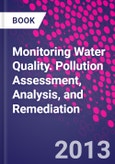Monitoring Water Quality is a practical assessment of one of the most pressing growth and sustainability issues in the developed and developing worlds: water quality. Over the last 10 years, improved laboratory techniques have led to the discovery of microbial and viral contaminants, pharmaceuticals, and endocrine disruptors in our fresh water supplies that were not monitored previously.
This book offers in-depth coverage of water quality issues (natural and human-related), monitoring of contaminants, and remediation of water contamination. In particular, readers will learn about arsenic removal techniques, real-time monitoring, and risk assessment. Monitoring Water Quality is a vital text for students and professionals in environmental science, civil engineering, chemistry - anyone concerned with issues of water analysis and sustainability assessment.
Please Note: This is an On Demand product, delivery may take up to 11 working days after payment has been received.
Table of Contents
1 Overview of Sustainability of Water Quality 2 Water Quality and Trends in US 3 Rivers in Africa Are in Jeopardy 4 Multiple Water Quality Problems with Septic Systems in Coastal Environment 5 Monitoring Water Contaminants Including Pharmaceuticals and Endocrine Disruptors 6 Risk Assessment and Remediation 7 Analytical measurements to improve nonpoint pollution assessments in Indiana's Lake Michigan Watershed 8 Real-time and Near Real-time Monitoring Options for Water Quality 9 Removing Chemical Contaminants Including Pharmaceuticals from Water Using Radical Reactions 10 Horseradish Peroxidase Mediated Stabilization of 2,4-Diclorophenol in a Model SOM-free Soil 11 Mechanistic Studies on the Interaction of Cactus Mucilages with Arsenic 12 Arsenic Sorption Dynamics on Composite Iron Matrix for Efficient Arsenic Water Filter Design 13 First Community-based Sustainable Arsenical Removal System in Cambodia 14 Arsenic Removal from Drinking Water and Ion-Exchange Brine Using Polysaccharide-Bridged Iron-based Nanoparticles 15 Transforming Arsenic Crises into an Economic Enterprise 16 Monitoring Water from Source to Tap: The New Paradigm for Insuring Water Security and Quality Evaluation 17 Evaluation of Environmentally Sustainable Strategies to Address Challenges Associated with Water Quality and Shortage








